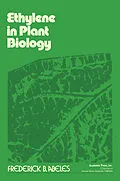Ethylene in Plant Biology focuses on the role of ethylene in plant physiology and the interrelationship between ethylene, fruit ripening, and respiration. It summarizes the physiology, biochemistry, production, regulation, plant effects, metabolism, and mechanism of action of ethylene. This book presents an introduction to basic chemistry of ethylene and available techniques for its sampling and analysis. Then, it discusses the rate, environmental conditions, and reactions involved in ethylene production. Chapter 4 examines the effects of herbicides and hormones, such as auxin, gibberellins, cytokinins, and abscisic acid, on ethylene production. Meanwhile, the next chapter studies the so-called stress ethylene phenomenon in plants. In particular, this book examines the role of insects, temperature, water, gamma-irradiation, and mechanical and chemical stimuli in stress ethylene. The biochemical aspects of ethylene are covered in the subsequent chapters. These include its role in growth and development of plant, phytogerontological activity, role in ethylene synthesis, respiration, pigmentation, and hormone regulation. Chapter 9 presents the activity of ethylene relative to other hydrocarbon analogs and dose-response relationships for a number of ethylene-mediated processes. The concluding chapters tackle the attachment of ethylene to its site of action, including epinasty, root initiation, intumescence formation, and floral initiation. A discussion on the issue of ethylene air pollution is included. This book will be useful to both undergraduate students and professional workers, especially those who have background in plant anatomy, plant physiology, or biochemistry.
Inhalt
Preface
1. Introduction
Text
References
2. Chemistry and Analysis of Ethylene
I. Chemistry
II. Ethylene Analysis
References
3. Physiology and Biochemistry of Ethylene Production
I. Variety of Organisms and Rates of Production
II. Environmental Control
III. Biochemistry of Ethylene Production
References
4. Hormonal and Herbicidal Regulation of Ethylene
I. Auxin
II. Gibberellins
III. Cytokinins
IV. Abscisic Acid
V. Growth Retardants
VI. Regulation of Ethylene Production by 2,4-D and Other Herbicides
VII. Ethrel and Other Ethylene-Releasing Chemicals
References
5. Stress Ethylene
I. Insects
II. Temperature
III. Water
IV. -Irradiation
V. Disease
VI. Mechanical Effects
VII. Chemical Effects
VIII. Conclusions
References
6. Growth and Developmental Effects of Ethylene
I. Dormancy
II. Growth
III. Epinasty
IV. Hook Opening
V. Induction of Roots and Root Hairs
VI. Hypertrophy
VII. Exudation
VIII. Flowering
IX. Gravitational Responses
X. Effect on Motor Cells
XI. Algae and Fungi
References
7. Phytogerontological Effects of Ethylene
I. Flower Fading and Leaf Senescence
II. Fruit Ripening
III. Abscission
References
8. Regulation of Metabolie and Physiological Systems by Ethylene
I. Role of Ethylene in Disease and Disease Resistance
II. Role of Ethylene in Enzyme Synthesis
III. Effect on Respiration
IV. Effects on Pigmentation
V. Regulation of Hormone Biochemistry and Physiology
VI. Cold Hardiness
References
9. Ethylene Analogs and Antagonists
I. Ethylene Analogs
II. Ethylene Antagonist-CO2
III. Dose-Response Relationships
IV. Other Compounds
References
10. Mechanism of Ethylene Action
I. Attachment Site
II. Effect on Isolated Enzymes
III. Membranes
IV. Regulation of Nucleic Acid and Protein Metabolism
V. Conclusions
References
11. Air Pollution and Ethylene Cycle
I. Background
II. Sources of Ethylene
III. Economic Losses Due to Ethylene Air Pollution
IV. Control of Air Pollution
V. Degradation of Atmospheric Ethylene
VI. Air Quality Standards
References
Author Index
Subject Index
